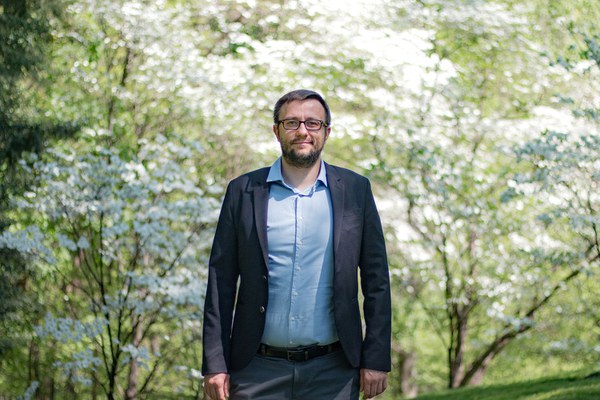Ivan Marić, a PhD candidate in classics, history, and archaeology at the University of Edinburgh, is a junior fellow in Byzantine Studies. His recent research report, “Imperial Ideology after Iconoclasm: Negotiating the Limits of Imperial Power in Byzantium, 843–913,” explored interactions between Byzantine political and religious leaders and the rewriting of history that occurred after iconoclasm’s end.
Q&A with Ivan Marić
Your talk began with the desecration of the remains of Constantine V, a major iconoclast emperor. Why was this desecration so exceptional?
First, it took place almost a hundred years after Constantine V’s death. Throughout Byzantine history there are similar instances of violence committed against the bodies of defeated emperors, but these typically occurred immediately after the individual’s execution. After Emperor Phokas was beheaded in 610, for example, his mutilated body parts were paraded in the streets and finally burned in a square. It was also exceptional because Constantine V’s remains, including his sarcophagus, were moved out of the imperial mausoleum in the Church of the Holy Apostles, which was ideologically a very important church. Removing an emperor from that site alone sends a strong message.
Further, the surviving account of Constantine’s desecration describes actions that are basically the same as those performed on the living, so the event was also, in part, a ritualized performance of humiliation and punishment—that is, a demonstration of justice. The description also suggests his remains suffered the sort of treatment reserved for traitors, tyrannical rulers, and heretics, which matches the image of Constantine V that had been created in anti-iconoclast literature and disseminated through sermons and liturgical feasts for decades.
It’s also possible that Constantine V’s desecration included a kind of mock trial, for which there’s a parallel in the West. In the late 9th century the remains of Pope Formosus were subjected to a similar trial—like Constantine, the pope’s body was wrapped in the vestments of his office, placed on a throne, and even given an attorney. Eventually, Formosus was convicted, and his remains were thrown into the Tiber.
Your talk focused on the repeated shifts in power between iconophiles and iconoclasts, and the political maneuvering between patriarchs and emperors that those shifts allowed for. Could you talk more about that dynamic?
Iconoclasm was at least as much a political issue as a theological one, and so the seesaw between iconoclast and iconophile religious policy between 754 and 843 was accompanied by a significant number of individuals switching sides on the issue, relatively easily, under imperial pressure or incentive.
The patriarchal position required a delicate balancing act. Patriarchs had to rely on imperial support, but they couldn’t let themselves be completely controlled by it. At the same time, there was great pressure from ecclesiastical and monastic structures to prevent imperial interference in matters of dogma. All this naturally harmed patriarchal authority and integrity.
After the restoration of orthodoxy in 843, a large-scale propaganda campaign was employed to counter this damage and create an image of the patriarchs as custodians of orthodoxy and the moral health of the community. It’s also important that the key patriarchal figures of the period—the patriarchs Tarasios, Nikephoros, and Photios—belonged to the highly educated metropolitan elite. Well-connected within the power networks of the city, they were in a good position to influence the discourse. Almost all texts that survive are distinctly anti-iconoclast in character and have an ecclesiastical provenance.
Is the evidence you’re working with mostly textual?
Since the ideological struggle manifested in various contexts and was transmitted through diverse media, my approach is interdisciplinary, drawing on written sources and visual and material evidence, like seals and coins, and the image program of the period, which is still visible in a few places, most importantly inside Hagia Sophia.
The texts are still a large part of my study, though. As I mentioned, I can’t think of many sources that don’t have an ecclesiastical provenance, and that, more specifically, don’t come from a fairly narrow circle of high-ranking ecclesiastic figures around the patriarchs. The highly influential Life of St. Stephen the Younger (who was martyred under Constantine V) and the so-called Theophanes Chronographia (the single most important historical work of the period which was also highly anti-iconoclast and anti-Constantine V) were produced in this circle, as well as the so-called Khludov Psalter, which depicts triumphant scenes of the iconophile patriarch Nikephoros trampling the last iconoclast patriarch, John Grammatikos.
What’s particularly interesting with this propaganda is that, because the messages advertised in texts were also transmitted through ceremonies and processions—because they were translated into the language of public performance—we can follow different modes of inscribing a particular vision of history into social memory.

